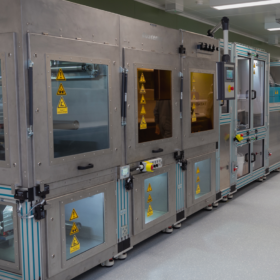E3/DC to replace 77 LG battery modules after fire in Germany
E3/DC says a residential battery integrated with an LG Energy Solution module recently caught fire in Werne, Germany, prompting the company to replace battery modules in 77 homes as a precaution. The cause of the blaze is still under investigation.
The Hydrogen Stream: US government offers $2.2 billion for H2 hubs
The US Department of Energy has revealed plans to allocate up to $1.2 billion for a hydrogen hub in Texas and the Gulf Coast and up to $1 billion for a similar project spanning Illinois, Indiana, Iowa, and Michigan.
Solarwatt presents new residential battery
German manufacturer Solarwatt says its new battery can be flexibly configured as an AC or DC system. It also features an emergency power function and can only be combined with Solarwatt inverters.
Coatema launches roll-to-roll production lines for organic, perovskite, dye-sensitized solar cells
German PV equipment company Coatema Coating Machinery says its roll-to-roll processing solutions cover from lab or pilot to production scale.
Scientists design 30.22%-efficient perovskite-silicon tandem solar cell with heterojunction bottom tech
An international research team has developed a perovskite-silicon tandem solar cell with a hole transport layer based on methyl-substituted carbazole and submicron-sized textured silicon bottom heterojunction cells. The proposed cell configuration uses commercially available Czochralski silicon wafers and promises efficiencies over 30%.
Inkjet printed formamidinium tin-lead perovskite cell with 10.26% efficiency
Researchers from Germany and India have demonstrated an inkjet printing method to fabricate formamidinium tin-lead perovskite solar cells, achieving 10.26% power conversion efficiency and a 1.25 eV energy bandgap.
Germany’s national, federal highways could host 54 GW of PV
A new study by Germany’s Federal Highway Research Institute (BASt) points to strong potential for solar deployment across the nation’s roadways and highways.
Juwi to build 20 MW/11 MWh solar-plus-storage project in Senegal
Juwi says it will construct a $33.2 million solar-plus-storage project in Senegal, integrating a 20 MW solar plant with 11 MWh of battery storage. The system will meet 20% of the energy needs of the Grande Côte mineral sands mine.
The Hydrogen Stream: EU offers financial support for renewable H2 auction
The European Commission, Austria, Lithuania, and Spain have announced new financial support measures for renewable hydrogen development as the European Union prepares for the second European Hydrogen Bank auction.
SAX Power releases 5.8 kWh residential AC battery
The German company said that its new storage solution also includes an integrated inverter function. It can be expanded to up to 17.3 kWh by connecting up to three modules.









